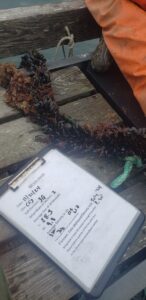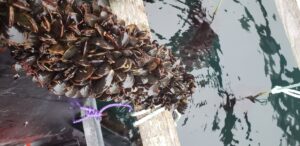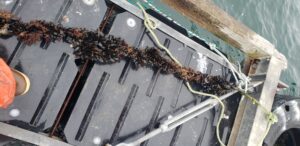Final report for FNE23-060
Project Information
Mussel farmers in Maine in the last eight years have noticed more variability in their wild mussel seed collection and a need for a hatchery alternative. Our farm Bangs Island Mussels has begun testing remote settling mussels larvae in our facility. In this project we sought to find the optimal rope type, either used pot warp or the industry standard fuzzy line, for best mussel seed recruitment and retention utilizing a remote settlement facility. We tested setting lines at a low density versus a high density. We set up four tanks with either pot warp or fuzzy line and six million pediveliger larvae were added to each tank to settle on lines for high density and rope type trials. In the low density 50 meters of fuzzy line were added to a tank with 500,000 pediveligers in the first trial then one million in the second. Larvae were reared in the facility for two weeks, labeled and deployed on the farm and monitored over the growing season. At the end of the growing season the line type trial lines were harvested, number of mussels, per line, weight per line and size of mussels was recorded before resocking the mussels to grow out until harvest at a lower density. Over the growing season a growth curve was established showing the pot warp mussels grew faster. In our initial trials starting in May of 2023 the first trial lines were heavily overset by a wild set of mussels after deployment. In the second trials, the low density lines were heavily overset by tunicates and the high density lines became tangled chafing off a majority of mussels. Our trials for rope type were repeated beginning in May of 2024. From those trials we saw the fuzzy line had higher mussel retention over the growing season. Our farm has concluded that more work is to be done in a time when mussel and tunicate larvae are low in the water and the fuzzy line is the optimal rope type to be used for our farm practices. Our remote settlement facility is located at our headquarters in Portland Maine we have had events that bring the public into our facility and though guest lectures at local colleges we are able to talk about all of the work we do for this project and farm operations. We have had other industry professionals and farmers visit our facility and farm who saw the remote settlement operation from the tank stage to growing out on the farm.
This project seeks to:
- Demonstrate a new way to supplement naturally recruiting seed on mussel farms to help grow mussel aquaculture in Maine.
- Compare more expensive industry-standard fuzzy rope and recycled lobster rope for their ability to recruit mussel pediveligers in a remote settlement tank, then ultimately how the ropes will each perform on the farm. This can identify potential cost savings for farmers and optimize the remote settlement process.
- Determine the stocking density per tank that will result in optimum settlement - lines stocked with ample seed, but not so many that the ropes will need to be stripped later on and the seed reattached to new lines at a lower density, as can happen in a natural set. This will help improve efficiency and reduce costs.
The US imports 32,000 metric tonnes of mussels, mostly from PEI as well as New Zealand, Vancouver and Chile. A bottleneck in Maine’s rope-grown mussel industry is the traditional reliance on mussel spat settling from the wild onto collector ropes. When a few Maine farmers recognized more variable natural settlement on their farms eight years ago, they approached Downeast Institute to see if an affordable hatchery alternative to natural settlement could be developed. The solution DEI developed consists of suspending ropes in tanks of sea water into which hatchery-spawned “eyed” pediveligers (larval mussels that are developing a foot and are nearly ready to settle from the water column onto a surface) are introduced. This technology enables farmers to receive supplemental seed if needed to mitigate variable settlement, or to increase production on their farm by staggering rope deployment beyond the natural season imposed by nature.
While Bangs Island is eager to benefit from this technology, the capacity of DEI to produce seeded mussel ropes is limited, and results will vary by farm. Through this project, Bangs Island could provide a “proof of concept” in Maine for on-farm or remote settlement. The results are intended to help shield mussel farms from the uncertainty of natural settlement which has been created by climate change, and help increase productivity on a farm using the same lease footprint it already occupies. Once Bangs Islands Mussels understands optimal rope type and stocking density, we will know how to use the remote settlement process most economically and with the greatest production impact. This knowledge will be transferred to other farmers to benefit the whole industry.
Bangs Island Mussels is a multi-species, near-coastal farm. We grow mussels, kelp, and now oysters on 10 sites in Casco Bay, Maine. We farm a total of 32 acres, we have been in business since 2010, and we currently produce around 600,000 lbs of mussels each year and around 100,000 lbs of kelp. We are a full-time, year-round farm with 18 employees.
Mussels are our primary crop. We grow them on 35 ft vertical dropper lines deployed from Spanish style rafts that are 40' square. We currently have 26 rafts in full, year-round production. Most of our mussel seed comes from wild seed collection after a mussel spawning event, which typically happens once a year. After we have captured wild mussel seed, we protect it and manage its density on our mussel lines by splitting and netting. When the mussels have reached our market sizes of nearly 3 inches, we harvest. We harvest mussels 2-4 times a week, year round.
From our 15 years in business, we had all of the equipment necessary to carry out this project, except for one larval settlement tank. To accomplish this project we used many company assets including: mussel rafts and designated space on the rafts to grow the lines, two different boats to transport and harvest mussel seed and transport crew to monitor the seed deployments, mussel harvest equipment, lab equipment, and mussel ropes.
Cooperators
- - Technical Advisor
Research
Trial 1. Rope type
Using the right type of rope is important to the success of a mussel farm. Some mussel farmers prefer commercial fuzzy rope made specifically for mussel farming, while others use discarded lobster pot warp (polypropylene rope). We conducted a trial at Bang’s Islands Mussel’s land based facility in Portland, Maine in May of 2023 to determine which type of rope has the best spat retention on our farm when the rope is seeded in our remote settlement tanks. We placed six PVC racks, each housing 50 meters of continuous rope and a one meter test rope, into each of four 1,000L remote settlement tanks. Two of the tanks held fuzzy rope and two tanks received used lobster pot warp. These tanks ran as flow-through, fed by a common head tank in which filtered seawater was heated to 70 F. A 120 micron banjo filter in each settlement tank allowed water to overflow while retaining the larvae. Each tank received fresh seawater at a rate of one gallon per minute. Each tank was aerated to evenly disperse larvae. 6,000,000 viable mussel pediveligers produced in DEI’s hatchery were added to each tank at the start of the trial.
Two weeks after the introduction of larvae, the racks were removed and the sample ropes from each rack were subsampled by cutting three 2-3 cm sections of rope to determine initial mussel density. The racks were labeled and deployed on Bang’s Island mussel rafts in Casco Bay. The remote settlement tanks were drained onto a 120 micron sieve and the number of dead mussel larvae were enumerated to help determine recruitment success.
The labeled mussel ropes suspended from the farm’s rafts were monitored monthly by lifting two ropes from each remote settlement tank at random and photographing them. 20 mussel seed were removed from each rope and measured to establish a growth curve over the growing season. At the end of the growing season the ropes were removed from the rafts and the mussel seed was stripped from each rope. The total weight of seed from each rope was recorded and 20 live mussels from each subsample were measured for further analysis.
Once all data was collected, we analyzed it to determine which rope type resulted in the highest initial density prior to deployment and at the end of the growing season. We also examined differences in growth between rope types. This information helped us to determine which rope type will lead to higher yield in a remote settlement scenario at our farm.
Trial 2. Density
Mussel farmers often find themselves with too many mussel seed on their settlement ropes in years when wild recruitment is high. The density of the seed must then be reduced by stripping the seed from the ropes and resocking it, at a proper density, onto growout ropes. This process is very labor intensive and costly to the farmer. If hatchery reared mussel larvae can be settled onto growout ropes at a proper density it may allow the farmer to skip this step in the husbandry process.
To test what initial density of mussel juveniles results in the most efficient yield of market product we set up a trial at Bang’s Island Mussel’s facility. We placed six PVC racks, each housing 50 meters of continuous fuzzy rope and a one meter sacrificial test rope, into each of four 1,000L remote settlement tanks as above. 6,000,000 viable mussel pediveligers were added to each of two tanks (High Density) and 500,000 mussel pediveligers were added to one tank (Low Density) at the start of the trial. In the second trial the Low Density tank had 1,000,00 mussel pediveligers at the start of the trial. Tanks were monitored and banjo filters were cleaned twice a day.
Two weeks after the introduction of larvae, the racks were removed and the sample ropes from each rack were subsampled by cutting three 2-3 cm sections of rope for later determination of initial mussel density. The racks holding ropes were labeled and deployed on Bangs Island mussel farm in Casco Bay. The remote settlement tanks were drained as above to determine recruitment success.
The labeled mussel ropes suspended from the mussel rafts were monitored as above. 20 mussel seed was removed from each rope and measured to establish a growth curve over the growing season. At the end of the growing season the ropes from the high density treatment were removed from the rafts and the mussel seed were stripped from each individual rope. The yield from each rope was measured by taking ten subsamples that are weighted and the number of live mussels recorded. The total weight of seed from each rope was recorded and 20 live mussels from each subsample was measured for further analysis. The seed was then resocked onto growout ropes and suspended from the raft. The ropes from the lower density treatment were photographed and 20 mussels from each rope were measured.
The density trials attempted in 2023 had results that ended in early termination of trials due to either a heavy overset of wild mussels or tunicates. These trials were not replicated in 2024. Our monitoring of the water column during the time of those trials indicated the presence of tunicates and wild mussel spat. Our farm has deployed a new density trial in February and March of 2025. Results have yet to be seen from those trials.
Trial 3. Nursery Step
A nursery step may be necessary to allow the recently settled mussel larvae to securely attach to the growing ropes before being deployed on open ocean growing sites. Nursery sites have lower wave energy which may allow the mussel to create a stronger bond to the lines. Do to a lack of suitable nursery sites near Portland, the nursery trials were cancelled.
Trial 4. Repeat
At the end of August, 2023 the treatment that was currently showing the most promise was repeated by Bangs Island Mussels without the aide of the Technical Advisor. This further reinforced the results and demonstrated the ability of farmers to use the technique without more technical assistance.
Due to the the high occurrence (near 100% of trial lines) of line tangles and wild mussel overset, line type trials were repeated. Monitoring was done to predict and avoid wild mussel sets and line lengths were adjusted to avoid tangles.
Our farm had performed two density trials in May and June of 2023. A third trial testing high density pot warp was added in July of 2023. At the time of deployment, the mussel monitoring program saw low levels of mussel larvae in the water column. By the second trials larvae levels had decreased before deployment. Tunicate monitoring had not been established until August of 2023. Once lines were deployed on the farm, monthly checks were instituted checking density and mussel size. The weight of 20 mussels did not register on the scale during our time checking these lines. While sizes were measured, at most only 3 data points were taken and a growth curve could not be established. Density on the farm was our main data point tracked. The results are as follows:
|
Trial |
Initial Starting Larvae in tanks |
Recruitment % |
Density (mussels/ft) at time of Deployment |
Density 1st Check |
Density 2nd Check |
End of Trial |
Result |
|
5/16/23 High Density Pot Warp |
6,000,000 |
90 |
4954 |
300 |
200 |
Wild Mussel Overset |
Trial Ended |
|
5/16/23 Low Density Fuzzy Line |
500,000 |
75 |
506 |
375 |
350 |
Wild Mussel Overset |
Failure |
|
6/29/23 High Density Pot Warp |
6,000,000 |
81 |
4866 |
650 |
375 |
Tangles |
Trial Ended |
|
6/29/23 Low Density Fuzzy Line |
1,000,000 |
62 |
591 |
30 |
20 |
Tunicate Overset |
Failure |
|
7/11/23 Pot Warp |
6,000,000 |
90 |
3000 |
50 |
50 |
Tangles |
Trial Ended |
Both high density trials had better recruitment percentages compared to the low density trials. Our first trial was deployed on 6 June 2023, they were checked one month later and the high density had only 6.1% of mussels remaining from the day deployment. Initially the low density trials had better on the farm retention. In the following trial the high density had better on the farm mussel retention. The third checks for density trials were taken at the beginning of October 2023. At this time the decision to end the first and second trials was made. A wild mussel spawn had occurred during the middle of June in 2023. Those mussels were about the same size as the remotely settled mussels. Our team could no longer identify the mussels needed to measure. We were unable to confidently interpret any results from those trials beyond initial recruitment to the lines before the wild mussel overset. Densities recorded including overset seed taken during the third check had nearly tripled. A decision was made to end the trial after this check. The second low density trials had not seen this overset, but instead tunicates were observed to settle on the line by the first check. Tunicate monitoring was incorporated into the monitoring program shortly after this observation and tunicate densities were noted in the following checks. Densities of mussels continued to decrease and tunicate densities increased to cover the lines. At the third check in October 2023, tunicates had fully outcompeted the mussels and the trial was deemed a failure with all lines hauled. The high density lines from the same trial (6/29/23) had all been observed to tangle. In the third trial for 2023, only a high density trials testing pot warp was conducted due to the presence of tunicate larvae in the water. These following lines had tangled shortly after deployment losing a majority of mussels. This prompted the team to shorten the pot warp lines to 15 feet. It was decided to repeat trials again in 2024.
In photo "A" above, shows one of the low density trial lines that had been overset with wild seed. Photo "B" was the second check of the following low density lines.
In 2024 all trial lines used a high density. The trials began with larvae arriving to Bangs Island Mussels in May 2024. At this time wild mussel larvae and tunicate larvae were observed to be present in the water column. Density trials were postponed until mussel larvae and tunicate larvae were not present in the water column. In addition, to gather as much data as possible, we instituted bi-weekly farm checks instead of monthly checks. Unfortunately, the harvest data will not be collected until after this project concludes.
In these trials testing line types larvae was received in May and June of 2024. The hatchery larvae were set onto the trial lines in the remote settlement facility. After two weeks, in preparation for deployment on the farm, samples as described above were taken from each trial to determine an average density of mussels on the trial lines. When the tanks were drained before deploying the lines on the farm, all of the water was run through a 120 micron sieve so that the number of unattached mussels could be counted. The number of deceased, unattached mussels was recorded to add to recruitment data. Our trials are labeled for the month the larvae were received in the remote settlement facility.
|
Trial |
Deployment Density |
% Recruitment |
|
Pot Warp May |
5552 mussels/ft |
91.6% |
|
Fuzzy May |
7775 mussels/ft |
92.70% |
|
Pot Warp June |
5215 mussels/ft |
86.05% |
|
Fuzzy June |
8014 mussels/ft |
93.50% |
In the rope type trials, two lines were sampled bi-weekly measuring the length of at least 20 mussels and once it registered on the scale, the weight of 20 mussels. Pictures of the lines were taken and saved.
Growth over time was graphed to show differences between line types in each trial. In the first trial the mussels seemed to grow at about the same rate, but the mussels on the fuzzy line were smaller throughout the trial. In the second trial the mussels were about the same size until 15 September. The pot warp lines grew bigger than those on the fuzzy lines.
The following photos are taken from our monitoring checks. All photos labeled as #A are the fuzzy line trials of May 2024. All photos labeled #B are the pot warp trials of May 2024. All photos labeled #C are the fuzzy line trials of June 2024. All photos labeled #D are the pot warp trials of June 2024.
1A.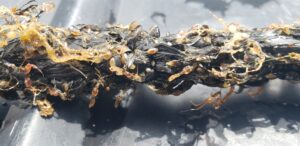 1B
1B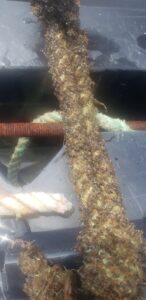
Figure 1A is the first fuzzy line trial sample and figure 1B is the pot warp sample taken the same day.
Figure 2A and 2C are our fuzzy line trials from the second check in taken in late July 2024. Photos 2B and 2D are our pot warp trials
3A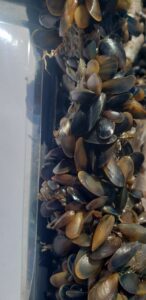 3B
3B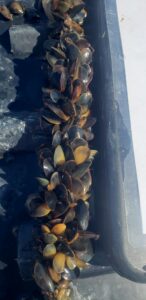 3C
3C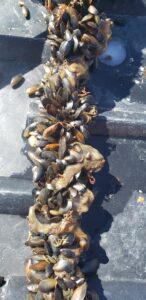 3D
3D 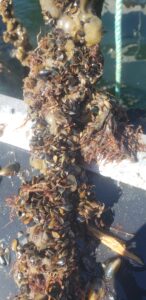
Photos 3A and 3C are the fuzzy line checks from August of 2023. Photos 3B and 3D are the pot warp trials from the same check
Photos above are from a check in September.
Photos above are from checks in October 2024.
The photos above are from the checks done in November 2024 before lines were split.
Once the mussels were a size of about 35mm they were split and the weight of the total harvest, weight of 20 mussels and average size were recorded. Sub-samples of 1 pound were taken from each line, size and number or mussels were recorded. The weight of the whole harvest was taken. From the sub-samples the overall number of mussels was calculated. Using the density and size from clean droppers set at the same time as the trial lines the amount of overset of wild mussels was seen to be 1% or less of mussels harvested. The size of those mussels was significantly smaller than those deployed from the RSF. When calculating the number of mussels harvested, the overset was excluded.
When looking at the results from splitting the lines it is important to note that the pot warp lines are only 15 feet and the fuzzy lines are 35 feet with more surface area. While the trials were deployed about a month apart, they were also split about a month apart and had about equal growth time on the farm.
|
Trial |
Line Harvested(ft) |
lbs of seed |
Avg. 20 mussels (lbs) |
Avg. weight per line(lb) |
Average weight(lbs) per ft |
Number of Mussels Harvested |
|
Pot Warp(May) |
990 |
2143 |
0.1 |
32.5 |
2.2 |
312878 |
|
Pot Warp(June) |
945 |
1721 |
0.09 |
27.3 |
1.82 |
335400 |
|
Fuzzy (May) |
455 |
1140 |
0.1 |
87.7 |
2.5 |
155040 |
|
Fuzzy(June) |
385 |
1040 |
0.09 |
94.5 |
2.7 |
350880 |
|
Average of 20 Mussels (Fuzzy) |
Weight(lb) |
Length(mm) |
|
May |
0.1 |
38 |
|
June |
0.1 |
34 |
With having to restart trials in 2024, the harvest data from these trials will be collected after the conclusion of this project’s time frame.
The results of this project indicate that in the remote settlement facility stage, initial recruitment is better on the standard fuzzy dropper. Between the two years of trials our recruitment in the settlement facility stage is increasing across all line types. From the results of the latest set of trials one line type did not outperform the other in all categories. The fuzzy line had better recruitment and farm retention, but the pot warp had faster growth over the growing season.
The density trials had inconclusive results, however they brought up new topics to study and potential for the future. When low density lines are to be used, then they would need to be deployed in a time when tunicate larvae numbers are low to non-existent. Our farm has begun trialing this in February and March of 2025. The mussels need to establish themselves on the line and grow to fill in all spaces of the line to prevent other fouling organisms settling. It is thought that those lines could also be used for collecting more wild seed. A low density set out on the farm site in a time when tunicate larvae are low and the bivalve larvae are present and could attract wild mussels to settle.
From the first year of pot warp trials and tangles of lines cut to 35 feet our farm changed practices. For all trials following, pot warp was kept to a maximum length of 15 feet. Shortening those lines increased space needed to set all lines down, but just for a summer until the lines could be split and reseeded. The benefit of this line type was that the seed was observed to grow fast than those on the fuzzy lines.
From the standard fuzzy droppers it was observed that there was slower growth deeper in the water column. Tunicates settled below 20 feet and increased in density until the bottom of the line. The monitoring of these lines called for monthly checks, but due to issues with previous rounds the team installed bi-weekly checks. More monitoring allowed BIM to create a stronger growth curve and spot differences between rope types. This monitoring partnered with larval monitoring of the surrounding waters and deployment of clean tester lines helped to determine potential timing, size and density of a wild mussel overset.
The team added density sampling to the checks. It was observed that density varied across the whole dropper and varied between droppers. The results from this sampling showed no exact pattern of loss, but it is important to note that in any sample taken the density was less than 50% of what was measured from initial deployment. This indicates that from deployment on the farm to the time the mussels are visible to the naked eye at least 50% or more are lost. In the remote settlement facility the team has recorded an initial recruitment percentage of at least 85% or higher on all, but one trial. Future study of farm deployment strategies or a nursery stage may be needed to improve retention rates when the mussels are transferred to the farm.
In this project our goal at Bangs Island Mussels was to understand the optimal rope type and densities for the greatest production impact utilizing the remote settlement process. This knowledge could then be transferred to other farmers in the industry. We received larvae from Down east Institute, set the larvae in settlement tanks with prepared lines and then once ready deployed on the farm until either it was ready to be split or harvested.
In the first objective of this project, we tested the industry standard fuzzy line and used pot warp line to see which had better spat retention in the facility and on the farm. The recruitment data taken before deployment indicates that the fuzzy line had higher initial recruitment than the pot warp. On the farm monitoring shows that while both seemed to have linear growth those on the pot warp grew larger in the same timeframe. In our June trials the fuzzy lines retained more individual mussels than the pot warp. For our farm uses, going forward the fuzzy line will be more optimal for our farming practices. While mussels grow faster on the pot warp, the fuzzy lines require less space, require less overall effort per line and from our trials appear to retain more mussels. Outside of those benefits the fuzzy lines are easier to harvest, can be used at all stages on the farm and there are less additional resources such as weights needed to deploy. Every bit of space counts for our farm, the fuzzy lines provide more yield per raft space and with lower effort per line. Our results indicate our farm will use a fuzzy line moving forward.
The second objective of our trials was to test density. When seed is collected at too high of a density farmers need to split the seed and put it onto lines at a proper density which can be labor intensive and utilize more resources. Our initial trials were to test a high and low density of mussels. The goal for the low density was to see if we could control density in the hatchery step and skip the resocking later. In the first of these trials, the mussels were overset with a wild seed set that was a similar size and we could not differentiate between hatchery and wild. In the second trials the low density was set on the fuzzy line and the high density was set on pot warp. Our low density trial was overset by tunicates, no mussels survived over the summer and lines were pulled from the water. The higher density pot warp lines had no other fouling seen, but most had tangled because they were too long and the trials were lost. From these trials we learned to monitor more environmental cues and when a better deployment time could be. The future goal is to find the ideal density that would be high enough to prevent other fouling organisms to settle, including other mussels, but low enough that we would not need to split. Our farm has added more frequent checks of our lines and added weekly monitoring of fouling organisms to inform deployment times.
Education & Outreach Activities and Participation Summary
Participation Summary:
Our remote settlement facility(RSF) is located at our headquarters in Portland Maine. This provides a great way to show off what we do. Through events hosted in Portland such as Walk the Working Waterfront it allowed members of the public to view our facility and we could show off the RSF. In combination with physical pictures posted it allowed for the public to get a good understanding of our trials. One of our employees is part of an apprenticeship program and one of the requirements of that program is for all apprentices to tour the farms. This brought at least five oyster farmers and two industry professionals out to our farm and they saw the on the farm trials as well as the RSF. Another employee has given guest lectures at two different local colleges talking with over 50 students and professors/researchers about our trials and what prompted this project. At our headquarters we have given tours to industry professionals from SEAGrant and they were able to see the facility in action.
Learning Outcomes
In talking with other farmers on our farm and some oyster farmers the key areas that they report changes in knowledge, attitude, skills and awareness from our remote settlement trials are centered around our changing oceans, data gathering and being able to add to their wheelhouse of seed collection. They expressed how in previous years timing has been based around an arbitrary date or has been very reactive. From our first trials that had inconclusive results or tangles, this provided skills in monitoring the environment, tracking changes and understanding more about environmental cues. At first, this project had not been viewed by the farmers in a very positive light, but as deployment strategies improved and wild collection became less reliable the appreciation for this work improved. Most of the negative attitudes came from unfamiliarity and not seeing a need for it. That changed over the course of the project as there were traditional methods that became less reliable.
The farmers liked how remote settlement provides more control for them. They liked that you could be more in control of when you set your lines and could potentially have a more consistent size of product throughout the year. It provides a source to add to inventory. They learned what techniques worked in theory or in the lab, but when it came to working on the farm those techniques needed to be refined or adjusted. They said they learned more about density and how a high density deployed before tunicate larvae are present can provide seed in a time that is becoming the most unreliable. The awareness of our changing seas has grown. They also mentioned they felt their awareness of how more growing techniques like this will be needed in the future to be able to thrive with warming seas and more invasive species such as tunicates that make wild collection more difficult. They have also said that they appreciate that this project has given them new tools on tracking data such as larvae and seed growth and line density. They liked that this gave them knowledge on how to have possibly more control of their inventory. While they might not have a need for this specific project, the oyster farmers have gained knowledge of how mussel farms seed their farms and more mussel farming knowledge in general.
Project Outcomes
For our farm, this project has started to change our mussel collection timing. Because of this project, our farm has added more monitoring to our farm sites. As stated previously, wild collection is becoming less reliable and this project has allowed us to find methods that work for our farm operations and farm sites in Casco Bay. It is on going work, but it has the potential to fill gaps in inventory if needed or give the ability to deploy lines when there is not a wild set to collect. If our farm one day is unable to wild collect seed, knowing how to do this work effectively means that the farm is prepared and would not need to spend the time then to find the methods that work. It gives us farmers a little more control on when sizes of mussels could be ready. Traditionally there was one collection of mussels, collected at one time of year that would grow out over the course of eighteen months. Going between seed classes there is a typically a large size difference. Remote setting mussels allows farms to add mussels at a middle date between collections to help keep size consistent between year classes. Consistency is good for all. A consistent product going through machines is easier to calibrate machine to and for a brand, customers can expect the same product year round.
Outside of the direct project results we have learned a lot of what can be useful for future trials and future research. Through this project the farm has added a tunicate monitoring program, which helps in determining timing of potential low density trials and for typical wild seed collection. It has helped to determine a more optimal seed size for splitting and reseeding. It has aided in some farm planning and helping to determine initial seed growth rates. It has also narrowed down what is a more ideal density for mussel retention. The farm can use what knowledge gleaned from the RSF lines and use that for deciding when or if to split a wild collection.
From the farmer perspective and moving forward to build this work into the future of the farm, the fuzzy line seems to be more ideal. The pot warp did have faster growth, but those lines took more space on the farm initially. With limited space on the mussel raft system the fuzzy lines seem to be the ideal rope type to use. It produces about the same amount of seed, with slightly slower growth, but in less space. At this moment the farm still has the ability to collect a wild set. While these lines are growing out on the farm before splitting it is during a time when the farm wild collects and all spaces on the farm are needed. If a nursery stage can be added and the lines are not taking valuable collection space from other farm operations that would be ideal. The RSF has the ability to add to inventory and bridge a size gap between year classes of mussels. These lines can be a reliable source of seed that is much needed especially in the late spring and early summer when the traditional methods of seed collection have shown to be more variable and some have failed.
From this project, we saw some differences between line type, but ultimately for our farm and our spacial limitations the fuzzy line seems to be optimal. If we are splitting at a smaller size, the differences in size should not be a hindrance and could provide the farm with more time to be able to split those lines while those mussels are still a smaller size and retention could be higher. The question of setting at a lower density has yet to be answered, but this project has allowed us to narrow down a time frame and environmental conditions are ideal to deploy those mussel lines and a starting point of how many mussels are too few to prevent overset of all fouling organisms. Having to restart this project has answered many questions along the way. In the last few years the wild seed collection has become variable and tunicate growth has increased. Overall the wild seed collection is not fully reliable. Hatchery reared mussels provide a steady source of mussels to supplement inventory and potentially create a reliable source of product to base the farm's future planning and growth on. From these trials, ultimately we have learned that we can set mussels at a high density and deploy on the farm when mussel larvae and tunicate larvae are low in the water in order to produce a reliable source of seed.
Using our farm as a case study we think that other raft culture mussel farms can benefit from our research. Farms that are starting to see less success with their wild collection could benefit from this. Farms that might need to add to their inventory at different times of year could also use this. Downeast Institute provides other farms with a source of seed and/or pre-seeded lines, but they are limited on space. For farms who want to try a remote settlement approach they can see our work and setup to get started and see what might work best for their operations. We have learned from our failures and keep trialling more to see what is best for our farm. This work is important to our farm currently and increasingly so as we grow.
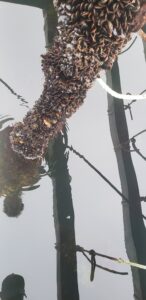
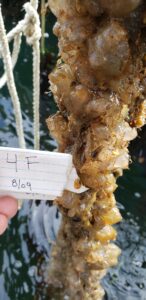
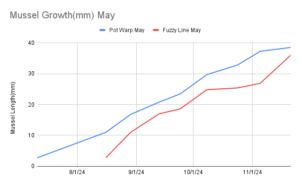
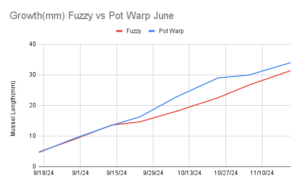
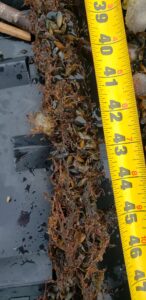
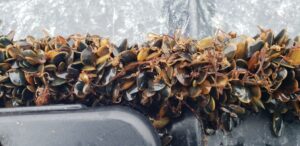
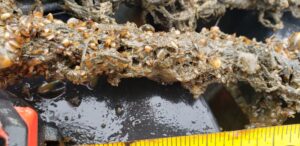
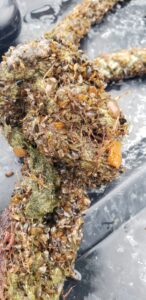
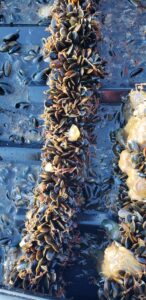 4B
4B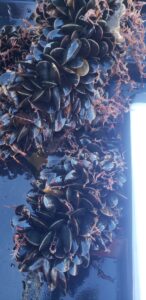 4C
4C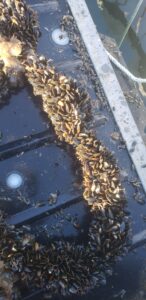 4D
4D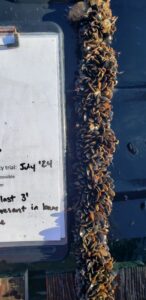
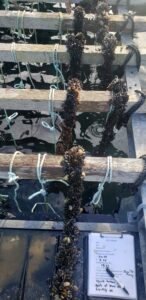
 5C
5C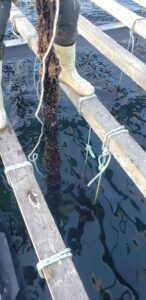
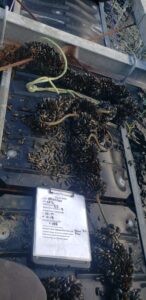
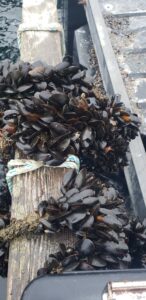 6B
6B 